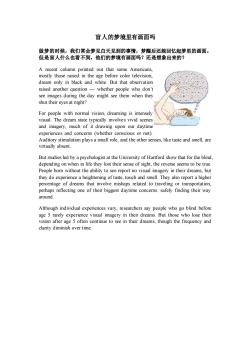《新编大学英语》综合教程(第三版第二册)B2U5_Self-market_Reading Material_盲人的梦境里有画面吗

盲人的梦境里有画面吗 做梦的时候,我们常会梦见白天见到的事情,梦醒后还能回忆起梦里的画面。 但是盲人什么也看不到,他们的梦境有画面吗?还是想象出来的? A recent column pointed out that some Americans, mostly those raised in the age before color television, dream only in black and white.But that observation raised another question-whether people who don't see images during the day might see them when they shut their eyes at night? For people with normal vision,dreaming is intensely visual.The dream state typically involves vivid scenes and imagery,much of it drawing upon our daytime experiences and concerns (whether conscious or not) Auditory stimulation plays a small role,and the other senses,like taste and smell,are virtually absent. But studies led by a psychologist at the University of Hartford show that for the blind, depending on when in life they lost their sense of sight,the reverse seems to be true People born without the ability to see report no visual imagery in their dreams,but they do experience a heightening of taste,touch and smell.They also report a higher percentage of dreams that involve mishaps related to traveling or transportation, perhaps reflecting one of their biggest daytime concerns:safely finding their way around Although individual experiences vary,researchers say people who go blind before age 5 rarely experience visual imagery in their dreams.But those who lose their vision after age 5 often continue to see in their dreams,though the frequency and clarity diminish over time
盲人的梦境里有画面吗 做梦的时候,我们常会梦见白天见到的事情,梦醒后还能回忆起梦里的画面。 但是盲人什么也看不到,他们的梦境有画面吗?还是想象出来的? A recent column pointed out that some Americans, mostly those raised in the age before color television, dream only in black and white. But that observation raised another question — whether people who don’t see images during the day might see them when they shut their eyes at night? For people with normal vision, dreaming is intensely visual. The dream state typically involves vivid scenes and imagery, much of it drawing upon our daytime experiences and concerns (whether conscious or not). Auditory stimulation plays a small role, and the other senses, like taste and smell, are virtually absent. But studies led by a psychologist at the University of Hartford show that for the blind, depending on when in life they lost their sense of sight, the reverse seems to be true. People born without the ability to see report no visual imagery in their dreams, but they do experience a heightening of taste, touch and smell. They also report a higher percentage of dreams that involve mishaps related to traveling or transportation, perhaps reflecting one of their biggest daytime concerns: safely finding their way around. Although individual experiences vary, researchers say people who go blind before age 5 rarely experience visual imagery in their dreams. But those who lose their vision after age 5 often continue to see in their dreams, though the frequency and clarity diminish over time
按次数下载不扣除下载券;
注册用户24小时内重复下载只扣除一次;
顺序:VIP每日次数-->可用次数-->下载券;
- 《新编大学英语》综合教程(第三版第二册)B2U5_Self-market_Reading Material_梦是黑白的还是彩色的.docx
- 《新编大学英语》综合教程(第三版第二册)B2U5_Self-market_Reading Material_关于梦境:十个你可能不知道的真相.docx
- 《新编大学英语》综合教程(第三版第二册)B2U5_Self-market_Reading Material_Meanings in Dreams.docx
- 《新编大学英语》综合教程(第三版第二册)B2U5_Self-market_Listening Material_Transcript.docx
- 《新编大学英语》综合教程(第三版第二册)B2U5_Self-market_06 B2U05 QUIZ.doc
- 《新编大学英语》综合教程(第三版第二册)B2U5 Translation & Writing.ppt
- 《新编大学英语》综合教程(第三版第二册)B2U5 Read by critical thinking.ppt
- 《新编大学英语》综合教程(第三版第二册)B2U5 Menu.ppt
- 《新编大学英语》综合教程(第三版第二册)B2U5 Activate.ppt
- 《新编大学英语》综合教程(第三版第二册)B2U4_Spellbound.docx
- 《新编大学英语》综合教程(第三版第二册)B2U4_Self-market_Writing Material_推展段落方法之——举例法.docx
- 《新编大学英语》综合教程(第三版第二册)B2U4_Self-market_Samples.docx
- 《新编大学英语》综合教程(第三版第二册)B2U4_Self-market_Reading Material_The Psychology of Money.doc
- 《新编大学英语》综合教程(第三版第二册)B2U4_Self-market_Reading Material_Marriage Wards off Blues.doc
- 《新编大学英语》综合教程(第三版第二册)B2U4_Self-market_Reading Material_Leisure Guilt.docx
- 《新编大学英语》综合教程(第三版第二册)B2U4_Self-market_Reading Material_Desk Psychology.doc
- 《新编大学英语》综合教程(第三版第二册)B2U4_Self-market_Listening Material_Transcript.docx
- 《新编大学英语》综合教程(第三版第二册)B2U4_Self-market_06 B2U04 QUIZ.doc
- 《新编大学英语》综合教程(第三版第二册)B2U4 Translation & Writing.ppt
- 《新编大学英语》综合教程(第三版第二册)B2U4 Read by critical thinking.ppt
- 《新编大学英语》综合教程(第三版第二册)B2U5_Self-market_Sample.docx
- 《新编大学英语》综合教程(第三版第二册)B2U5_Self-market_Writing Material_推展段落方法之——叙述法.docx
- 《新编大学英语》综合教程(第三版第二册)B2U6 Activate.ppt
- 《新编大学英语》综合教程(第三版第二册)B2U6 Menu.ppt
- 《新编大学英语》综合教程(第三版第二册)B2U6 Read by critical thinking.ppt
- 《新编大学英语》综合教程(第三版第二册)B2U6 Translation & Writing.ppt
- 《新编大学英语》综合教程(第三版第二册)B2U6_Self-market_06 B2U06 QUIZ.doc
- 《新编大学英语》综合教程(第三版第二册)B2U6_Self-market_Listening Material_Transcript.docx
- 《新编大学英语》综合教程(第三版第二册)B2U6_Self-market_Reading Material_Food and Mood.docx
- 《新编大学英语》综合教程(第三版第二册)B2U6_Self-market_Reading Material_Is chocolate really good for me.docx
- 《新编大学英语》综合教程(第三版第二册)B2U6_Self-market_Reading Material_每天吃相同的食物会影响健康吗.docx
- 《新编大学英语》综合教程(第三版第二册)B2U6_Self-market_Samples.docx
- 《新编大学英语》综合教程(第三版第二册)B2U6_Self-market_Writing Material_推展段落方法之——比较与对比法.docx
- 《新编大学英语》综合教程(第三版第二册)B2U6_料理鼠王transcript.docx
- 《新编大学英语》综合教程(第三版第二册)B2U4_Self-market_06 B2U04 QUIZ_B2U4 Oral Quiz.ppt
- 《新编大学英语》综合教程(第三版第二册)B2U3_Self-market_B2U03 QUIZ_06 B2U3 Quiz.doc
- 《新编大学英语》综合教程(第三版第二册)B2U3_Self-market_B2U03 QUIZ_B2U3 Oral Quiz.ppt
- 《新编大学英语》综合教程(第三版第二册)B2U5_Self-market_B2U05 QUIZ_B2U5 Oral Quiz.ppt
- 《新编大学英语》综合教程(第三版第二册)B2U6_Self-market_B2U06 QUIZ_B2U6 Oral Quiz.ppt
- 《新编大学英语》综合教程(第三版第二册)B2U2_Self-market_B2U2 Grammar and Vocabulary.doc
